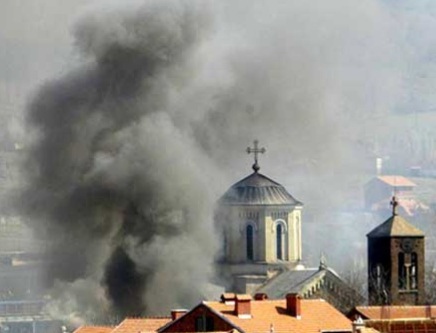 When is a Serb a Serb and when is a Serb an Orthodox Christian? When is a Serb a practicing Orthodox Christian?
When is a Bosnian a Bosnian and when is a Bosnian a Bosnian Muslim? When is a Bosnian Muslim a practicing Bosnian Muslim or even an Islamist Bosnian Muslim?
When is a Serb a Serb and when is a Serb an Orthodox Christian? When is a Serb a practicing Orthodox Christian?
When is a Bosnian a Bosnian and when is a Bosnian a Bosnian Muslim? When is a Bosnian Muslim a practicing Bosnian Muslim or even an Islamist Bosnian Muslim?
These are the kinds of issues that journalists faced when covering the horrors of Bosnia-Herzegovina and, quite frankly, few reporters were up to the challenge. Los Angeles Times reporter Alissa J. Rubin -- marking the 10-year anniversary of the Srebrenica massacre -- ventured back into this journalistic minefield in a new report that bravely attempts to remind readers just how complex this region was and is.
As an Orthodox Christian, I can be accused of reading the story with an agenda. So be it. I am very aware that journalists during the fighting there had a tendency to say that all Serbians were Orthodox. Meanwhile, on the ground, leaders of the Serbian Orthdox Church were often attacked by the same Serbian government thugs loyal to Slobodan Milosevic -- neo-Communist criminals who hated believers of all stripes -- who proudly massacred Muslims and Catholics. Here is a Scripps Howard column I wrote back in 1999 trying to sort some of that out. It's complex stuff.
And so is the territory that Rubin is trying to map. Clearly, this region is still haunted and almost all of the ghosts are religious, to one degree or another. The various religious groups live in a tense standoff, living their own lives in a divided land. The divisions are increasing with the passage of time, not healing.
Of course, "healing" is defined in this article as religious people compromising and erasing the lines between their faiths. "Progress" equals a loss of religious tradition. But this does not seem to be happening. Strong forms of faith tend to stay strong and gain strength.
Here is a sample, describing life among Bosnian Muslims:
Although Muslims, Serbs and Croats sometimes live side by side in the big cities or in neighboring hamlets in the countryside, they say they live in different worlds. The inter-ethnic and inter-religious marriages that were commonplace in the big cities before the war have almost entirely disappeared.
Muslims have developed "a consciousness of their identity as a nation and an awareness of their religion," said liberal columnist Gojko Beric, a Bosnian Serb who lives in a mixed neighborhood of Sarajevo, the Muslim-majority capital. Before the war, most Bosnian Muslims, especially those in Sarajevo, rarely attended prayers except for the most holy days of the year and had friends from different groups. Few women wore head scarves.
Today, the Muslim call to prayer sounds from mosque loudspeakers five times a day -- a reminder that the largest group in the country follows a different religion from that of the minority Serbs, who are Orthodox Christians, and Croats, who are Catholic.
Let me make one other comment. For Orthodox Christians, the bloody land of Kosovo has been described as the "Jerusalem of Serbia," with 1,300 churches, monasteries and holy sites. Many of those are now in ruins, and the destruction goes on and on. There is no hint of that.
Again, I know that I am biased. I also know that Rubin could not deal with all of the wounds, all of the horrors. I also know -- because I have tried to cover some of these stories -- that the radical Muslims often burn the shrines of the believing Christians, just as the secular Serbs once massacred the families of Muslim believers. It is hard to keep the players straight in this kind of deadly game.
UPDATE: Well now. It appears that it is also possible to cover this story and pretty much ignore the religious complexity altogether. Check out this shallow New York Times report. Maybe the copy desk simply gutted the reporter's work and this is what we were left with.
